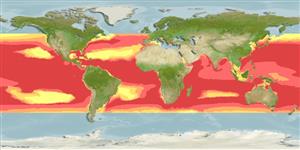Environment: milieu / climate zone / depth range / distribution range
Ekologi
laut; oceanodromus (Ref. 51243); kisaran kedalaman 0 - 1000 m (Ref. 43). Subtropical; 22°C - 31°C (Ref. 43); 50°N - 45°S, 180°W - 180°E (Ref. 43)
Atlantic Ocean: in tropical and temperate waters. We follow Nakamura 1985 (Ref. 43) in recognizing Makaira mazara and Makaira nigricans as two distinct species chiefly because of differences in the pattern of the lateral line system. Many scientists, however, do not recognize this character as specifically diagnostic and consider the latter species as a single pantropical species occurring in the Atlantic, Pacific and Indian oceans. Highly migratory species.
Length at first maturity / Size / Weight / umur
Maturity: Lm ?, range 50 - ? cm
Max length : 500 cm TL jantan/; (Ref. 11441); 500.0 cm TL (female); common length : 290 cm TL jantan/; (Ref. 6659); Berat maksimum terpublikasi: 636.0 kg (Ref. 40637); Berat maksimum terpublikasi: 636.0 kg
Duri punggung (Keseluruhan (total)) : 0; duri punggung lunak (Keseluruhan (total)) : 45 - 50; Duri dubur: 0; Sirip dubur lunak: 19 - 23. Body blue-black above and silvery white below, with about 15 rows of pale cobalt-colored stripes; 1st dorsal fin plain blackish or dark blue, other fins brown black with a tinge of dark blue in some specimens; anal fin bases with a tinge of silvery white. Lateral line a network of interconnecting canals (Ref. 26938).
An oceanic species. Water color affects its occurrence, at least in the northern Gulf of Mexico, where the fish show preference for blue water. Rarely gathers in schools and usually found as scattered single individuals. Feeds mainly on fishes but also preys on octopods and squids. Marketed fresh or frozen (Ref. 43). Feeding takes place during daytime. Maturity reached at about 80 cm in males and 50 cm in females (Ref. 36731). Females grow larger (Ref. 4770). Recent study indicates maximum age close to 20 years using a series of deductions in the ¹⁴C dating method (Ref. 120707).
Subripe ova are opaque, white to yellow, and 0.3 to 0.5 mm in diameter. Transparent spherical eggs flowing out of a ripe ovary measured 1 mm in diameter.
Nakamura, I., 1985. FAO species catalogue. Vol. 5. Billfishes of the world. An annotated and illustrated catalogue of marlins, sailfishes, spearfishes and swordfishes known to date. FAO Fish. Synop. 125(5):65p. Rome: FAO. (Ref. 43)
Status IUCN Red List (Ref. 130435: Version 2024-2)
ancaman kepada manusia
Harmless
penggunaan manusia
Perikanan: komersial; Ikan buruan: ya
Alat, peralatan
laporan khas
muat turun XML
Sumber internet
Estimates based on models
Preferred temperature (Ref.
123201): 11.5 - 27.3, mean 22.4 °C (based on 477 cells).
Phylogenetic diversity index (Ref.
82804): PD
50 = 0.7505 [Uniqueness, from 0.5 = low to 2.0 = high].
Bayesian length-weight: a=0.00427 (0.00255 - 0.00714), b=3.11 (2.96 - 3.26), in cm total length, based on LWR estimates for this species & (Sub)family-body (Ref.
93245).
Trophic level (Ref.
69278): 4.5 ±0.3 se; based on diet studies.
Generation time: 3.4 ( na - na) years. Estimated as median ln(3)/K based on 1
growth studies.
Daya lenting (Ref.
120179): sedang, Waktu penggandaan populasi minimum 1.4 - 4.4 tahun (K=0.1-0.3).
Prior r = 0.44, 95% CL = 0.29 - 0.66, Based on 6 full stock assessments.
Fishing Vulnerability (Ref.
59153): Moderate to high vulnerability (52 of 100).
Climate Vulnerability (Ref.
125649): Moderate to high vulnerability (50 of 100).
Nutrients (Ref.
124155): Calcium = 23.3 [9.7, 43.0] mg/100g; Iron = 0.898 [0.478, 1.711] mg/100g; Protein = 19.8 [18.5, 21.0] %; Omega3 = 0.245 [0.123, 0.499] g/100g; Selenium = 71.6 [34.5, 159.4] μg/100g; VitaminA = 3.61 [0.99, 13.41] μg/100g; Zinc = 0.283 [0.180, 0.446] mg/100g (wet weight);
